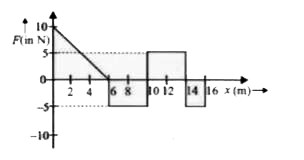A particle which is experiencing a force given by →F=3→i−12→j, undergoes a displacement of →d=4→i. If the particle had a kinetic energy of 3 J at the beginning of the displacement, what is its kinetic energy (in joule) at the end of the displacement?
To solve the problem, we will follow these steps:
Step 1: Identify the Given Information
We have:
- Force →F=3^i−12^j N
- Displacement →d=4^i m
- Initial kinetic energy KEi=3 J
Step 2: Calculate the Work Done
The work done W by the force during the displacement can be calculated using the dot product of the force and displacement vectors:
W=→F⋅→d
Calculating the dot product:
→F⋅→d=(3^i−12^j)⋅(4^i)=3⋅4+(−12)⋅0=12+0=12 J
Step 3: Apply the Work-Energy Theorem
According to the work-energy theorem, the change in kinetic energy is equal to the work done:
KEf−KEi=W
Where:
- KEf is the final kinetic energy.
- KEi is the initial kinetic energy.
Rearranging the equation gives us:
KEf=W+KEi
Step 4: Substitute the Values
Now we can substitute the values we have:
KEf=12 J+3 J=15 J
Final Answer
The final kinetic energy of the particle at the end of the displacement is 15 J.
---
We have:
- Force →F=3^i−12^j N
- Displacement →d=4^i m
- Initial kinetic energy KEi=3 J
The work done W by the force during the displacement can be calculated using the dot product of the force and displacement vectors:
According to the work-energy theorem, the change in kinetic energy is equal to the work done:
- KEf is the final kinetic energy.
- KEi is the initial kinetic energy.
Now we can substitute the values we have:
The final kinetic energy of the particle at the end of the displacement is 15 J.
Topper's Solved these Questions
- BOOK - DISHA PUBLICATIONCHAPTER - CHAPTERWISE NUMERIC /INTEGER ANSWER QUESTIONSEXERCISE - CHAPTER 6 (SYSTEM OF PARTICLES AND ROTATIONAL MOTION)14videos
CHAPTERWISE NUMERIC /INTEGER ANSWER QUESTIONS
- BOOK - DISHA PUBLICATIONCHAPTER - CHAPTERWISE NUMERIC /INTEGER ANSWER QUESTIONSEXERCISE - CHAPTER -7 (GRAVITATION)15videos
CHAPTERWISE NUMERIC /INTEGER ANSWER QUESTIONS
- BOOK - DISHA PUBLICATIONCHAPTER - CHAPTERWISE NUMERIC /INTEGER ANSWER QUESTIONSEXERCISE - CHAPTER -4 (LAWS OF MOTION)15videos
CHAPTERWISE NUMERIC /INTEGER ANSWER QUESTIONS
- BOOK - DISHA PUBLICATIONCHAPTER - ATOMSEXERCISE - EXERCISE-2: CONCEPT APPLICATOR30videos
ATOMS
- BOOK - DISHA PUBLICATIONCHAPTER - COMMUNICATION SYSTEM EXERCISE - EXERCISE-2 : Concept Applicator30videos
COMMUNICATION SYSTEM
Similar Questions
A particle which is experiencing a force, given by →F=3→i−12→j, undergoes a displacement of →d=4→i. If the particle had a kinetic energy of 3 J at the beginning of the displacement
View SolutionDuring a storm, a crate of crepe is sliding across a slick, oily parking lot through a displacement →d=(−3.0m)ˆi while a steady wind pushes against the crate with a force →F=(2.0N)ˆi+(−6.0N)ˆj. The situation and coordinate axes are shown in Fig. 8-6.
If the crate has a kinetic energy of 10 J at the beginning of displacement →d, what is its kinetic energy energy at the end of →d ?View Solution
Knowledge Check
- Question 1 - Select One
A particle is executing SHM with an amplitude 4 cm. the displacment at which its energy is half kinetic and half potential is
A1 cmB21/2cmC2cmD2(2)1/2cm - Question 2 - Select One
For a particle performing a S.H.M. the potential and kinetic energies will be equal when the displacement of the particle is
AABA2CA√2DA√2 - Question 3 - Select One
A particle is acted upon by a force F which varies with position x as shown in figure. If the particle at x * 0 has kinetic energy of 25 J, then the kinetic energy of the particle at x = 16 m is
 A45 JB30 JC70JD20 J
A45 JB30 JC70JD20 J
The deBroglie wavelength of a particle of kinetic energy K is λ. What would be the wavelength of the particle, if its kinetic energy were K4?
View SolutionDraw the graph between displacement and
kinetic energy for a particle executing SHM.View SolutionA particle excutes SHM, at what value of displacement are the kinetic and potential energies equal?
View SolutionThe total energy of a particle in linear S.H.M. is 20 J. What is its kinetic energy when its displacment is half of the amplitude ?
View SolutionA particle undergoing SHM has the equation x=Asin(2ωt+ϕ) , where x represents the displacement of the particle. The kinetic energy oscillates with time period
View Solution

